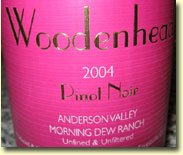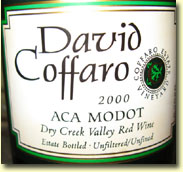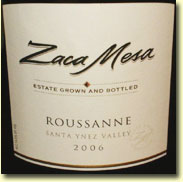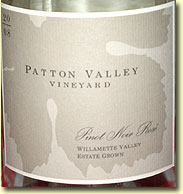|

|




Part I and
Part III

The dinner with
Al Stewart
really got the week off with a bang, but the remainder of the week’s
wines turned out to be pretty good, too, although perhaps not quite as
rarified as the old Burgundies. First up was a 2004 Woodenhead Pinot
Noir, “Morning Dew Ranch”, from Anderson Valley. This had been given
to me by my store’s
supplier of Woodenhead, as we had bought both the 2005 and 2006 vintages
for the store, and both have been quite well received. Although not that
well known, Woodenhead has a very important pedigree in the world of
California Pinot Noir. The owner/winemaker is
Nikolai Stez, who for 17 years was the assistant winemaker at
Williams Selyem, generally regarded
as one of California’s preeminent producers of Pinot Noir. Stez left W-S
after the sale to focus on his own project, but he didn’t cut his ties
to W-S entirely, at least not to the “Williams” side of the equation.
You see, “Morning Dew Ranch” is a small vineyard up in Mendocino’s
Anderson Valley, and is owned by . . . Burt
Williams. So this is about as close to W-S as you can get
without actually buying Williams Selyem. remainder of the week’s
wines turned out to be pretty good, too, although perhaps not quite as
rarified as the old Burgundies. First up was a 2004 Woodenhead Pinot
Noir, “Morning Dew Ranch”, from Anderson Valley. This had been given
to me by my store’s
supplier of Woodenhead, as we had bought both the 2005 and 2006 vintages
for the store, and both have been quite well received. Although not that
well known, Woodenhead has a very important pedigree in the world of
California Pinot Noir. The owner/winemaker is
Nikolai Stez, who for 17 years was the assistant winemaker at
Williams Selyem, generally regarded
as one of California’s preeminent producers of Pinot Noir. Stez left W-S
after the sale to focus on his own project, but he didn’t cut his ties
to W-S entirely, at least not to the “Williams” side of the equation.
You see, “Morning Dew Ranch” is a small vineyard up in Mendocino’s
Anderson Valley, and is owned by . . . Burt
Williams. So this is about as close to W-S as you can get
without actually buying Williams Selyem.
The 2005 and 2006 vintages of this wine are wonderfully transparent
examples of fine Pinot Noir, with exquisite aromatics, medium color and
body, and that combination of elegance and “power without weight”, to
borrow Allen Meadows’ wonderful
expression for the ideal Pinot Noir. This 2004, the first vintage from
Morning Dew Ranch, however, was a bit of a disappointment. Surprisingly
ripe and soft, the wine shows some candied elements that almost suggest
a bit of residual sugar, exacerbated by lowish acidity and gobs of fruit
on the darker end of the spectrum. This is power with weight, certainly
not a bad wine and actually quite tasty with richer food, but not really
what I look for in Pinot. 2004 was a problematic vintage for Pinot
throughout California, as extreme heat spikes just prior to harvest
drove sugars higher than most conscientious winemakers would like,
leading to wines that push the ripeness envelope. Although this one was
well made, it clearly didn’t escape the excessive sugars of the vintage.
Oh well, clearly both the vineyard and winemaker found their footing in
2005 and 2006. Find these wines |
|
 The following night I was going out with my old
college roommate and his family to a rather wine-unfriendly Tunisian
restaurant. Linda decided to stay
home, so I opened a 2000 David Coffaro “Aca Modot” (Dry Creek)
for her to enjoy in my absence. Of course, I couldn’t resist taking a
sip, solely to make sure the wine was good enough for my lovely wife to
enjoy. David Coffaro is a blender
par excellence, and his Aca Modot bottling reflects his conception of a
Bordeaux/Meritage blend, although with a somewhat non-traditional cepage.
The wine is 54% Cabernet Sauvignon; 17% Cabernet Franc; 12% Barbera; 10%
Merlot; 4% Petite Verdot; and 3% Malbec. Despite the Barbera (which was
probably included to add a bit of acid grip), this was a delicious and
mature Sonoma Cabernet blend, and quite a good example considering the
weak 2000 vintage. Quite fragrant with cedar, tobacco, and cassis,
medium bodied with a good balance of acidity and smooth tannins, this
seems to be at a perfect point of maturity and is very enjoyable for
drinking now. Find this wine The following night I was going out with my old
college roommate and his family to a rather wine-unfriendly Tunisian
restaurant. Linda decided to stay
home, so I opened a 2000 David Coffaro “Aca Modot” (Dry Creek)
for her to enjoy in my absence. Of course, I couldn’t resist taking a
sip, solely to make sure the wine was good enough for my lovely wife to
enjoy. David Coffaro is a blender
par excellence, and his Aca Modot bottling reflects his conception of a
Bordeaux/Meritage blend, although with a somewhat non-traditional cepage.
The wine is 54% Cabernet Sauvignon; 17% Cabernet Franc; 12% Barbera; 10%
Merlot; 4% Petite Verdot; and 3% Malbec. Despite the Barbera (which was
probably included to add a bit of acid grip), this was a delicious and
mature Sonoma Cabernet blend, and quite a good example considering the
weak 2000 vintage. Quite fragrant with cedar, tobacco, and cassis,
medium bodied with a good balance of acidity and smooth tannins, this
seems to be at a perfect point of maturity and is very enjoyable for
drinking now. Find this wine
 Back at the shop, it was a slow week, as I had let my suppliers know I
was not tasting much during the month of April. Business is slow, and we
really don’t need a lot of new wines. I did make an exception for our
supplier of 2007 Klee Pinot Noir Find this wine
($18) from Oregon. I had brought
the Klee into the store last month, as I thought it was an excellent buy
in Pinot since we could price it at only $18.99. With its great Klee
artist label, the wine offers real class at a bargain price, with crisp
red-fruit Back at the shop, it was a slow week, as I had let my suppliers know I
was not tasting much during the month of April. Business is slow, and we
really don’t need a lot of new wines. I did make an exception for our
supplier of 2007 Klee Pinot Noir Find this wine
($18) from Oregon. I had brought
the Klee into the store last month, as I thought it was an excellent buy
in Pinot since we could price it at only $18.99. With its great Klee
artist label, the wine offers real class at a bargain price, with crisp
red-fruit flavors that are typically Oregon Pinot, backed with some real
minerality and surprising length. So I wanted to taste the winery’s main
label, called Roots. Actually, I learned that the winemaker,
Chris Berg, has three levels of
Pinot, with Klee the entry-level “bargain” label. The main brand is
called Roots, made from their 6.5 acre estate vineyard next door to the
famous Shea Vineyard, as well as some single vineyard wines from
purchased fruit. Their top of the line wine is called Racine,
named after Berg’s home town in Wisconsin. The 2007 Roots Estate
Pinot Noir Find this wine
($24) (Yamhill-Carlton District, Oregon) is quite good
from a challenging vintage in Oregon. Surprisingly ripe with blackberry
and cherry cola fruit, the wine is well-structured with good acidity and
firm tannins that seem ripe and smooth. The cool dark fruit flavors are
on the ripe end of the spectrum, but do not approach raisiny or
overripe. A slight shortness in the mid-palate is noticeable on the
finish, but still this is quite nice and classy for a wine that would
retail in the low to mid $20’s. I’m looking forward to trying the
single-vineyard Pinots from this producer later this month. I actually
liked it much better than the high-end 2006 Racine Pinot Noir Find this wine
($50) (also from Yamhill-Carlton). The first giveaway is the oversized,
heavyweight bottle—haven’t wineries gotten over the big bottle/big wine
fixation yet? The wine itself is like the bottle—oversized, clumsy, and
lacking any sense of grace or finesse. Huge, powerful, ripe and slightly
roasted fruit dominates, and there’s plenty of wood, too. Frankly
there’s little sense of typicity here, either in the varietal character,
or as an Oregon wine. This is just way too extracted and zin-like for
me, and is an easy pass. I’m looking forward to trying the 2007 Roots’
single vineyard wines later this month. flavors that are typically Oregon Pinot, backed with some real
minerality and surprising length. So I wanted to taste the winery’s main
label, called Roots. Actually, I learned that the winemaker,
Chris Berg, has three levels of
Pinot, with Klee the entry-level “bargain” label. The main brand is
called Roots, made from their 6.5 acre estate vineyard next door to the
famous Shea Vineyard, as well as some single vineyard wines from
purchased fruit. Their top of the line wine is called Racine,
named after Berg’s home town in Wisconsin. The 2007 Roots Estate
Pinot Noir Find this wine
($24) (Yamhill-Carlton District, Oregon) is quite good
from a challenging vintage in Oregon. Surprisingly ripe with blackberry
and cherry cola fruit, the wine is well-structured with good acidity and
firm tannins that seem ripe and smooth. The cool dark fruit flavors are
on the ripe end of the spectrum, but do not approach raisiny or
overripe. A slight shortness in the mid-palate is noticeable on the
finish, but still this is quite nice and classy for a wine that would
retail in the low to mid $20’s. I’m looking forward to trying the
single-vineyard Pinots from this producer later this month. I actually
liked it much better than the high-end 2006 Racine Pinot Noir Find this wine
($50) (also from Yamhill-Carlton). The first giveaway is the oversized,
heavyweight bottle—haven’t wineries gotten over the big bottle/big wine
fixation yet? The wine itself is like the bottle—oversized, clumsy, and
lacking any sense of grace or finesse. Huge, powerful, ripe and slightly
roasted fruit dominates, and there’s plenty of wood, too. Frankly
there’s little sense of typicity here, either in the varietal character,
or as an Oregon wine. This is just way too extracted and zin-like for
me, and is an easy pass. I’m looking forward to trying the 2007 Roots’
single vineyard wines later this month.
The following day we had a visit from Eric
Mohseni, winemaker for Zaca Mesa Winery in the Santa
Ynez Valley of Santa Barbara County. Zaca Mesa holds an important place
among Santa Barbara County wineries, mainly for its role as the
“launching pad” for some of the county’s most highly esteemed
winemakers. Ken Brown was their
first winemaker and later started Byron in Santa Maria Valley
(later sold to Mondavi), and he now has his own eponymous winery.
Jim Clendenen and
Bob Lindquist worked at Zaca Mesa
before venturing out on their own to start Au Bon Climat and
Qupé, respectively. Other alumni include
Lane Tanner, Daniel Gehrs,
Chuck Carlson (Curtis), and
Adam Tolmach (Ojai). Eric was
only recently appointed Zaca Mesa’s head winemaker, having served as
their assistant for a number of years. Going back a few years earlier,
Eric was employed by the same store I work for, The Wine Country
in Signal Hill. Eric really got his start in the wine biz at The Wine
Country serving several stints in the store in the mid to late 1990’s,
interspersed with various other gigs with wineries both domestic (Edna
Valley) and foreign (Esk Valley in New Zealand’s Hawkes Bay
region). As an assistant at Zaca Mesa, Eric had started his own label,
Osseus, focusing on Sauvignon Blanc, and it’s a damn good one at
that (a little Syrah is made as well). Naturally, The Wine Country
supports the Osseus brand, and the 2007 is simply a terrific example of
a Santa Ynez Sauvignon, with a great blend of flinty, grapefruity and
herbal fruit, not too grassy, with great cut from pinpoint acidity.
Worth seeking out. But Eric visited to taste me on the most recent
releases from Zaca Mesa, so here we go.
 Most
of the wines we tasted were actually made by the previous winemaker,
since Eric was promoted only in 2008, but the 2008 Z Gris
Rosé Find this wine
($16) is Eric’s baby. Mostly Grenache, with about 10% Cinsault,
with the fruit picked for rosé, not sagnier juice taken from another
wine. Very clean and crisp with some nice berry and mineral notes, good
energy and nerve, good finish. A really nice summer rosé. Next up was
the 2008 Viognier Find this wine
($18), which frankly was better than I was
expecting. I’m not a huge Viognier fan, as too many domestic versions
from this grape are rather oversized and flabby, unctuous but rather
plodding. But this one’s nicely fruity with the typical peach and
apricot notes, plus some savory herbs, all supported by better acidity
than many other Viogniers I’ve tasted. Not a heavyweight, but still with
good richness, finishing with a hint of bitter almond. Quite good and
very well balanced. I also liked the 2007 Chardonnay Find this wine
($18), which
does not see malolactic fermentation, or any new oak (only neutral
barrels are used). Most
of the wines we tasted were actually made by the previous winemaker,
since Eric was promoted only in 2008, but the 2008 Z Gris
Rosé Find this wine
($16) is Eric’s baby. Mostly Grenache, with about 10% Cinsault,
with the fruit picked for rosé, not sagnier juice taken from another
wine. Very clean and crisp with some nice berry and mineral notes, good
energy and nerve, good finish. A really nice summer rosé. Next up was
the 2008 Viognier Find this wine
($18), which frankly was better than I was
expecting. I’m not a huge Viognier fan, as too many domestic versions
from this grape are rather oversized and flabby, unctuous but rather
plodding. But this one’s nicely fruity with the typical peach and
apricot notes, plus some savory herbs, all supported by better acidity
than many other Viogniers I’ve tasted. Not a heavyweight, but still with
good richness, finishing with a hint of bitter almond. Quite good and
very well balanced. I also liked the 2007 Chardonnay Find this wine
($18), which
does not see malolactic fermentation, or any new oak (only neutral
barrels are used).
 Again very clean and crisp, a hint of herbs again but
not suffering from any vegetal or wet hay aromas that I get in some
non-ML/no-oak chards. A nice clean chardonnay, perhaps a bit
nondescript, but very nice for the price (under $20). The last white was
the 2006 Roussanne Find this wine
($25), which sees 60% new oak, but doesn’t
taste overly oaky. Only a portion of the wine is allowed to go through
ML, contributing to the crisp acids that support the rather weighty
texture. Some herbal and mineral notes seem varietally correct, but the
character of the wine is again a bit nondescript at this point, not
easily identifiable as a Roussanne (although not clearly like anything
else, either). The balance is there, so perhaps some bottle age will
allow the Roussanne-ness to develop further. Again very clean and crisp, a hint of herbs again but
not suffering from any vegetal or wet hay aromas that I get in some
non-ML/no-oak chards. A nice clean chardonnay, perhaps a bit
nondescript, but very nice for the price (under $20). The last white was
the 2006 Roussanne Find this wine
($25), which sees 60% new oak, but doesn’t
taste overly oaky. Only a portion of the wine is allowed to go through
ML, contributing to the crisp acids that support the rather weighty
texture. Some herbal and mineral notes seem varietally correct, but the
character of the wine is again a bit nondescript at this point, not
easily identifiable as a Roussanne (although not clearly like anything
else, either). The balance is there, so perhaps some bottle age will
allow the Roussanne-ness to develop further.
The red wines began with their Chateauneuf-style red blend, the 2006
Z Cuvée Find this wine
($20). Made up of 59% Grenache, 23% Mourvedre, 15% Syrah,
and 3% Cinsault, the wine is medium-bodied, low in tannins and a bit low
in acid as well, with sour cherry fruit that is rather direct and
simple. This is basically a straightforward, easy-drinking red wine of
no particular character or distinction, but decent enough for burgers or
BBQ. A bit better is the 2005 Syrah Find this wine
($23), showing more of the
spice and garrigue notes I would have expected in the Z Cuvée; in fact,
this wine was more Chateauneuf-like than Northern Rhone, despite being
pure Syrah. Fairly light  for a Central Coast Syrah, and simple, but
tasty all the same. Much bigger, richer, and with far more to it all the
way around is the top-of-the-line 2005 “Black Bear Block” Syrah
Find this wine
($58), a limited bottling that is mostly sold to their mailing list.
From the oldest Syrah block in Santa Barbara County (planted in 1978),
this is all about blackberry fruit with notes of licorice. Very rich
with excellent acids and firm, smooth tannins, this is really superb,
although not exactly a bargain at the suggested retail price of nearly
$60. We finished with the high-end GSM blend, known as the 2005
Z-Three Find this wine
($45). With 46% Syrah, 40% Mourvedre, and 14% Grenache, this
is more Northern Rhone than Southern in style. Not as big as the Black
Bear Block, with more red fruits to go with some black fruits and herbal
notes; smoother tannins suggest this is ready for earlier drinking. for a Central Coast Syrah, and simple, but
tasty all the same. Much bigger, richer, and with far more to it all the
way around is the top-of-the-line 2005 “Black Bear Block” Syrah
Find this wine
($58), a limited bottling that is mostly sold to their mailing list.
From the oldest Syrah block in Santa Barbara County (planted in 1978),
this is all about blackberry fruit with notes of licorice. Very rich
with excellent acids and firm, smooth tannins, this is really superb,
although not exactly a bargain at the suggested retail price of nearly
$60. We finished with the high-end GSM blend, known as the 2005
Z-Three Find this wine
($45). With 46% Syrah, 40% Mourvedre, and 14% Grenache, this
is more Northern Rhone than Southern in style. Not as big as the Black
Bear Block, with more red fruits to go with some black fruits and herbal
notes; smoother tannins suggest this is ready for earlier drinking.
Overall, these are nice wines, although in general I liked the whites
and rosé a bit better than the reds. The style up until now has been for
medium bodied wines meant for early consumption, perhaps a bit simple
but tasty, and ideal for restaurant wine lists. Whether Eric can get a
bit more intensity and complexity into the wines will be his biggest
challenge. Until then, I’d consider Zaca Mesa a good, solid “middle of
the road” producer in Santa Barbara, but worth watching as the new
winemaker takes charge and puts his stamp on the wines.
 The week ended with unseasonably warm weather for April here in SoCal,
with temps up into the 90’s. That can only mean one thing—it’s rosé
season! Our store happens to sell the most rosé of any store in
California (over 500 cases last Summer), and we’re already stocking up
with the best 2008’s we can find from around the world. At summer’s peak
we’ll probably have 20-30 different rosés in stock at any given time. I
decided to start off with one from France, and one from Oregon: The week ended with unseasonably warm weather for April here in SoCal,
with temps up into the 90’s. That can only mean one thing—it’s rosé
season! Our store happens to sell the most rosé of any store in
California (over 500 cases last Summer), and we’re already stocking up
with the best 2008’s we can find from around the world. At summer’s peak
we’ll probably have 20-30 different rosés in stock at any given time. I
decided to start off with one from France, and one from Oregon:
2008 Domain Sorin “Terra Amata”, Côtes de Provence ($9.99).
Always our most popular French rosé, the Domaine Sorin delivers as
expected in 2008. Pale salmon color, just the way I like my rosés, good
fruit that emphasizes the flinty, minerally notes of a good rosé, with
pinpoint acidity and crunchy cranberry and strawberry fruit flavors,
this just goes down waaaay too easily. Find this wine
 2008 Patton Valley Vineyard Pinot Noir Rosé (Willamette Valley,
$14.99). Patton Valley made our favorite domestic rosé of 2007, so we
bought all we could for 2008, and they appear to have done it again.
Similar color to the Sorin, but much more fruity, with terrific lift
from both strong acidity and probably a bit of CO2, which gives the wine
great energy in the mouth. More of an emphasis on fruit over the
minerally notes of the Sorin, but very attractive, light, fresh, and
delicious for drinking on its own. An open bottle of this will be in my
‘fridge as long as it lasts. Find this wine 2008 Patton Valley Vineyard Pinot Noir Rosé (Willamette Valley,
$14.99). Patton Valley made our favorite domestic rosé of 2007, so we
bought all we could for 2008, and they appear to have done it again.
Similar color to the Sorin, but much more fruity, with terrific lift
from both strong acidity and probably a bit of CO2, which gives the wine
great energy in the mouth. More of an emphasis on fruit over the
minerally notes of the Sorin, but very attractive, light, fresh, and
delicious for drinking on its own. An open bottle of this will be in my
‘fridge as long as it lasts. Find this wine
Part I and
Part III
Bennett Traub
Reporting From The Left Coast
Send Bennett an
|



|